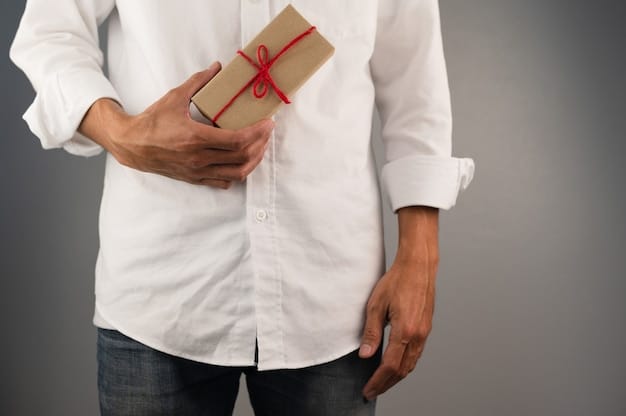The Art of Japanese Gift-Giving: A Guide for US Shoppers

The Art of Gift-Giving in Japan: A Guide for US Shoppers to Choose Appropriate Presents offers a comprehensive overview of Japanese gift-giving customs, helping US shoppers navigate cultural nuances to avoid misunderstandings and choose gifts that convey respect and thoughtfulness.
Navigating the world of gift-giving can be tricky, especially when crossing cultural boundaries. For US shoppers looking to give gifts in Japan, understanding the nuances of Japanese customs is essential. This guide, The Art of Gift-Giving in Japan: A Guide for US Shoppers to Choose Appropriate Presents, will help you choose appropriate and thoughtful gifts while avoiding potential cultural faux pas.
Understanding Japanese Gift-Giving Culture
Gift-giving in Japan, known as “oseibo” (year-end gifts) and “ochugen” (mid-year gifts), is deeply rooted in social obligation and etiquette. It’s not just about the gift itself, but the thought and care put into selecting and presenting it that truly matters.
Understanding these customs is crucial for American shoppers who want to make a positive impression and show respect for Japanese culture. From the types of gifts considered appropriate to the correct way to present them, every detail matters.
The Significance of Gift-Giving
In Japan, gifts are more than just material objects. They are symbols of gratitude, respect, and maintaining harmonious relationships. Gift-giving reinforces social bonds and demonstrates a sense of responsibility to others.
Occasions for Gift-Giving
While oseibo and ochugen are significant gift-giving seasons, there are many other occasions where gifts are appropriate, including:
- Housewarmings
- Weddings
- Birthdays
- Returning from a trip (omiyage)

Understanding the context of the gift is crucial. A gift given to express gratitude for a favor differs from a celebratory gift. Each occasion carries its own set of expectations.
Proper etiquette is paramount in Japanese culture, especially regarding gift-giving. Neglecting these customs can inadvertently cause offense or miscommunication. By understanding and adhering to these customs, US shoppers can ensure their gestures of goodwill are well-received.
In summary, Japanese gift-giving combines tradition and etiquette, reflecting a deeper respect for relationships and social harmony. US shoppers who familiarize themselves with these customs will be better equipped to navigate the art of gift-giving in Japan.
Choosing the Right Gift
Selecting the appropriate gift requires careful consideration, as some items are better received than others. Factors such as the recipient’s status, personal preferences, and cultural symbolism all play a role.
The “right” gift will depend on the context, occasion, and your relationship with the recipient. The most important factor is the thought that goes into the selection, which shows sincerity and respect.
Appropriate Gift Categories
Some popular and generally well-received gift categories in Japan include:
- Food and Beverages: High-quality fruits, sweets, tea, coffee, or regional delicacies.
- Household Items: Towels, soaps, or small appliances from reputable brands.
- Gift Certificates: For department stores or specific experiences.
Gifts to Avoid
Certain items carry negative connotations in Japanese culture and should be avoided:
- Sharp objects: Symbolize severing ties.
- Numbers 4 and 9: Considered unlucky due to their association with death and suffering.
- White flowers: Traditionally used at funerals.
It’s also important to be mindful of personal preferences and allergies. A thoughtful inquiry beforehand can prevent embarrassment or disappointment.

When in doubt, it’s best to opt for gifts that are consumable, practical, or well-known for their quality. Researching local customs and preferences can provide valuable insights. Consultation with someone familiar with Japanese culture is also a wise step, especially for significant gifts or formal occasions.
In conclusion, careful selection of gifts, avoidance of taboo items, and awareness of personal preferences are key to ensuring a positive reception. By paying attention to these details, US shoppers can demonstrate respect and thoughtfulness in their gift-giving in Japan.
The Importance of Presentation
Presentation is almost as important as the gift itself in Japanese gift-giving. The way a gift is wrapped and presented conveys thoughtfulness and respect. Sloppy or inadequate presentation can diminish the value of the gift, regardless of its cost or quality.
Japanese packaging is typically elegant and meticulous. Attention is paid to every detail, from the choice of wrapping paper to the placement of the ribbon. The goal is to create a visual representation of sincerity and consideration.
Wrapping Techniques
Traditional Japanese wrapping often utilizes “furoshiki,” a versatile wrapping cloth. Other popular methods include:
- Using high-quality wrapping paper with subtle patterns.
- Securing ribbons with care, often tied in specific knots.
- Adding a “noshi,” a decorative paper attachment signifying good luck.
The Art of the Bow
Presenting a gift with a slight bow is a sign of respect. The depth of the bow can vary depending on the relationship with the recipient and the formality of the occasion.
- A slight bow (15 degrees) is used for casual situations.
- A deeper bow (30-45 degrees) is reserved for more formal occasions.
- Holding the gift with both hands while bowing shows extra respect.
The cultural significance of presentation in Japan reflects a deep-seated appreciation for aesthetics and attention to detail. It’s not simply about covering the gift, but about enhancing its symbolic value.
US shoppers should consider investing in high-quality wrapping materials and taking the time to learn basic Japanese wrapping techniques. Even a simple gift can make a strong impression with thoughtful presentation. When in doubt, professional gift-wrapping services are readily available in Japan and can help ensure a polished and respectful presentation.
In short, presentation elevates the act of gift-giving beyond mere exchange and transforms it into a gesture of respect and goodwill. By paying attention to wrapping techniques, bowing etiquette, and overall appearance, US shoppers can communicate their sincerity effectively.
Understanding the Significance of Omiyage
“Omiyage” refers to souvenirs or gifts brought back from a trip to share with colleagues, friends, and family. It’s an integral part of Japanese culture, signifying thoughtfulness and a desire to share one’s experiences with others. Omiyage serves as a token of gratitude and consideration.
Bringing back omiyage is not just a kind gesture but often an unspoken social expectation. Failing to do so can sometimes be perceived as inconsiderate, especially in the workplace. It’s a way to maintain harmony within a group.
Selecting Omiyage
Effective tips for selecting omiyage include:
- Regional specialties: Choose items unique to the place you visited.
- Individually wrapped items: Easy to distribute among colleagues.
- Modest cost: Omiyage is about the gesture, not extravagance.
Distribution Etiquette
- Present omiyage upon return: Don’t delay the distribution.
- Offer with humility: Use phrases like “Trivial, but…” to avoid boasting.
- Give to everyone: Ensure no one is left out to avoid jealousy.
Even if a trip is for personal reasons, bringing back omiyage for colleagues is considered professional courtesy. The collective sharing of these small gifts fosters camaraderie.
For US shoppers, understanding omiyage can significantly enhance their relationships with Japanese counterparts. It demonstrates cultural awareness and a willingness to engage with local customs.
Understanding the concept of omiyage provides valuable insight into Japanese culture, it emphasizes the importance of sharing and maintaining positive relationships. US travelers who embrace this practice can significantly enhance their interactions and integration in Japanese society.
Navigating Group Gift-Giving
In Japan, group gift-giving is a common practice, especially in professional settings or among close-knit groups. It is a collective effort where several individuals pool their resources to purchase a more substantial gift than they could afford individually.
Usually, a leader or representative is chosen to coordinate the collection of funds and the selection of the gift. This ensures that the gift reflects the group’s sentiment and is appropriate for the occasion.
The Coordination Process
- Nominate a coordinator: Someone organized and trusted by the group.
- Set a budget: Determine an acceptable contribution amount.
- Gather input: Ask for suggestions regarding the gift.
Choosing a Group Gift
- Consider the recipient: What are their interests or needs?
- Opt for quality: Choose something durable and well-made.
- Ensure inclusivity: Avoid personalizing the gift too much.
Transparency is crucial in group gift-giving. Keeping everyone informed about the progress and decisions builds trust and prevents misunderstandings. Distributing a thank-you note from the recipient is also a thoughtful touch.
For US shoppers participating in group gift-giving in Japan, it’s essential to respect the established process. Offering to help or contribute ideas is welcome, but avoid taking over or imposing your own preferences.
Collective gift-giving promotes unity and shared appreciation. By participating respectfully and understanding the group dynamic, US shoppers can strengthen relationships and demonstrate cultural sensitivity.
Returning the Favor: Gift-Giving Reciprocity
Reciprocity, or “kaeshi,” is a fundamental aspect of Japanese gift-giving culture. It involves returning a gift or favor received within a reasonable timeframe, usually with something of similar or slightly lesser value. This practice maintains balance and harmony in relationships.
The concept of kaeshi is deeply ingrained in Japanese etiquette, reflecting a sense of obligation and the desire to maintain equitable relationships. Failing to reciprocate appropriately can be perceived as rude or unappreciative.
Timing and Value
- Return gifts promptly: Ideally within a week or two.
- Aim for half to equal value: The return gift should be of similar or slightly lesser value (usually half to a third).
- Consider the relationship: Adjust the value based on the level of intimacy.
Appropriate Return Gifts
- Sweets or snacks: A safe and appreciated option.
- Tea or coffee: Especially if the recipient enjoys these beverages.
- Small household items: Such as towels or soap.
Handwritten thank-you notes are always appreciated, even when an additional gift is given. Personalizing the note with a specific mention of the original gift adds a thoughtful touch. Avoid over-the-top displays of gratitude that may cause the giver embarrassment.
US shoppers should be prepared to reciprocate gifts received in Japan. It’s a sign of respect and ensures the continuation of positive relationships. Understanding the cultural expectations surrounding kaeshi is essential for navigating social interactions successfully.
The principle of kaeshi reinforces the value of balance and consideration in interpersonal relationships. By understanding and practicing reciprocity, US shoppers can demonstrate their respect for Japanese customs and foster stronger connections.
| Key Point | Brief Description |
|---|---|
| 🎁 Cultural Significance | Gift-giving expresses gratitude, respect, and maintains relationships. |
| 🚫 Gifts to Avoid | Avoid sharp objects, numbers 4 & 9, and white flowers as they carry negative connotations. |
| ✨ Presentation Matters | Presentation is key; use elegant wrapping, ribbons, and a slight bow to show respect. |
| 🤝 Reciprocity (Kaeshi) | Returning a gift with something of similar value maintains balance in relationships. |
Frequently Asked Questions (FAQ)
▼
Oseibo (year-end gifts) and Ochugen (mid-year gifts) are significant gift-giving seasons in Japan, deeply rooted in social obligation and etiquette. They are times to show gratitude to those who have helped you throughout the year.
▼
Appropriate Omiyage gifts are regional specialties from your travel destination, individually wrapped for easy distribution, and reasonably priced. The gesture is more important than extravagance.
▼
Kaeshi is the practice of reciprocating gifts or favors in Japan. It’s essential for maintaining balance and harmony in relationships. Always return a gift of similar or slightly lesser value promptly.
▼
Yes, certain items are considered taboo. Avoid sharp objects (symbolizing severing ties), the numbers 4 and 9 (associated with death), and white flowers (used at funerals). Be mindful of these cultural sensitivities.
▼
Presentation is extremely important. Use high-quality wrapping paper, elegant ribbons, and consider traditional wrapping methods like Furoshiki. The presentation shows thoughtfulness and respect.
Conclusion
Mastering the art of gift-giving in Japan as a US shopper is about more than just picking out a present; it’s about showing respect, understanding cultural nuances, and building stronger relationships. By following these guidelines, you can ensure your gifts are well-received and appreciated.





